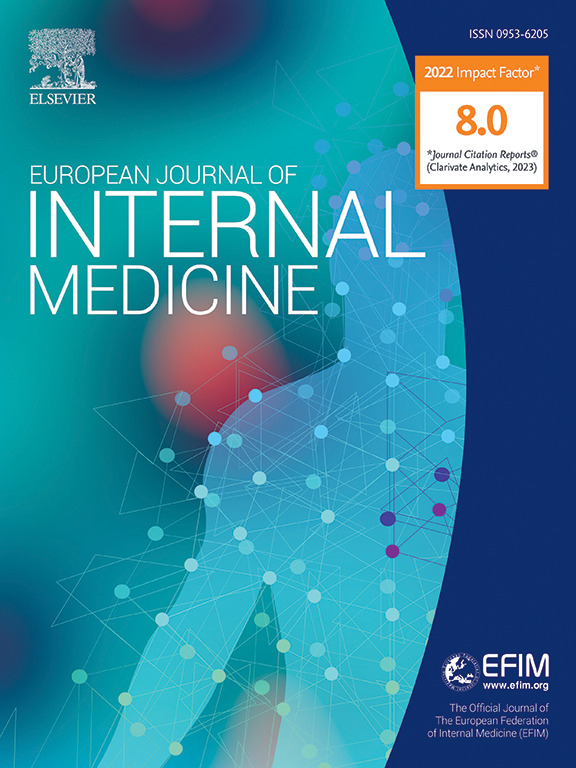深度低钠血症纠正后的神经和精神疾病-一项队列研究。
IF 6.1
2区 医学
Q1 MEDICINE, GENERAL & INTERNAL
引用次数: 0
摘要
方法:本研究的基础是斯德哥尔摩钠队列,这是一个实验室数据存储库,涵盖了斯德哥尔摩地区的居民,他们进行了钠浓度分析(2005-2018,n = 1632,249)。纳入研究期间首次入院的深度低钠血症患者,可计算前24小时的钠校正率。钠校正≤8和>8 mmol/L/24 h比较。结果:重度低钠血症住院7623例,其中男性3199例(42.0%),中位年龄70岁(IQR 59 ~ 80岁)。酒精滥用占18.3%,神经和/或精神疾病占52.4%,低钾血症占27.9%。3985例(52.3%)患者坚持推荐矫正率≤8 mmol/L/24 h。7例(0.09%)诊断为ODS, 6例矫正率为8 mmol/L/24 h(矫正率≤8 mmol/L 1例,P = 0.0441)。在完全校正模型(校正风险比1.02 95% CI 0.89-1.17)中,校正率≤8 mmol/L/24 h的患者与校正率高于8 mmol/L/24 h的患者发生新发神经或精神疾病的风险无显著差异(校正风险比1.02 95% CI 0.89-1.17)),在亚组中也无显著差异。结论:ODS是罕见的,但主要与快速纠正有关。因此,缓慢修正可能是可取的。本文章由计算机程序翻译,如有差异,请以英文原文为准。
Neurologic and psychiatric disorders following correction of profound hyponatremia - A cohort study
Background
Rapid correction of profound hyponatremia (serum sodium <125 mmol/L) has been associated with osmotic demyelination syndrome (ODS) but this has been challenged. Potential associations with other neurological and psychiatric diseases have not been studied.
Methods
The basis of this study was the Stockholm Sodium Cohort, a laboratory data repository covering inhabitants of the Stockholm Region who had a sodium concentration analyzed (2005–2018, n = 1632,249). Patients admitted with profound hyponatremia for the first time during the study period where sodium correction rates during the first 24 h could be calculated were included. Sodium correction ≤8 and >8 mmol/L/24 h was compared.
Results
Hospitalization with profound hyponatremia occurred in 7623 individuals, 3199 (42.0 %) were males, and the median age was 70 years (IQR 59–80 years). Alcohol misuse was present in 18.3 %, a neurological and/or psychiatric disease in 52.4 % and hypokalemia in 27.9 %. The recommended correction rate ≤8 mmol/L/24 h was adhered to in 3985 (52.3 %) patients. Seven patients (0.09 %) were diagnosed with ODS, six had a correction rate >8 mmol/L/24 h (compared to 1 patient with a correction rate ≤8 mmol/L, P = 0.0441). The risk of new neurological or psychiatric diseases did not differ significantly between those with a correction rate ≤8 mmol/L/24 h and those above in the fully adjusted model (adjusted hazard ratio 1.02 95 %CI 0.89–1.17)) nor in the subgroups.
Conclusions
ODS was rare, however, mainly associated with rapid correction. Consequently, slow correction may be preferable.
求助全文
通过发布文献求助,成功后即可免费获取论文全文。
去求助
来源期刊
CiteScore
9.60
自引率
6.20%
发文量
364
审稿时长
20 days
期刊介绍:
The European Journal of Internal Medicine serves as the official journal of the European Federation of Internal Medicine and is the primary scientific reference for European academic and non-academic internists. It is dedicated to advancing science and practice in internal medicine across Europe. The journal publishes original articles, editorials, reviews, internal medicine flashcards, and other relevant information in the field. Both translational medicine and clinical studies are emphasized. EJIM aspires to be a leading platform for excellent clinical studies, with a focus on enhancing the quality of healthcare in European hospitals.

 求助内容:
求助内容: 应助结果提醒方式:
应助结果提醒方式:


